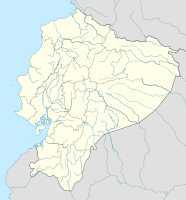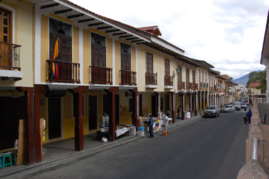Loja (Ecuador)
| Loja | ||
|---|---|---|
|
Coordinates: 3 ° 59 ′ S , 79 ° 12 ′ W Loja on the map of Ecuador
|
||
| Basic data | ||
| Country | Ecuador | |
| province | Loja | |
| Canton | Loja | |
| City foundation | December 8, 1548 | |
| Residents | 180,617 (2010) | |
| - in the metropolitan area | 214,855 | |
| City insignia | ||
| Detailed data | ||
| surface | 286 km 2 | |
| Population density | 632 inhabitants / km 2 | |
| height | 2060 m | |
| Waters | Río Zamora | |
| prefix | (+593) 7 | |
| Time zone | UTC -5 | |
| City Presidency | Jorge Bailón Abad | |
| Website | ||
| view on the city | ||
| The Lourdes street in the old town of Loja | ||
| Street in the old town of Loja | ||
Loja , also Inmaculada Concepción de Loja , is a town at the southern end of the Cordillera Real in Ecuador . It is 108 km to the Peruvian border. Loja has 130,000 inhabitants (2011) and is the capital of the province of the same name . The height of approx. 2380 m in the Andean highlands gives the place a mild climate all year round.
Loja is located on the Panamericana between Cuenca in the north and the border with Peru in the south, both about 5 hours by bus from Loja.
history
Loja was originally founded in 1546 on the orders of Gonzalo Pizzaro under the name La Zarza ("The Thorn Bush ") in the valley of Catamayo, a place where the Catamayo airport is located today . After malaria problems and a severe earthquake , Loja was re-established in 1548 at its current location. The new founder Don Alonso de Mercadillo came from Loja, Granada and gave the city the name of his homeland. Loja can therefore look back on almost 500 years of history. Loja was the starting point of numerous expeditions by the Spanish occupiers to plunder the gold of the Zaruma and Nambija region in southern Ecuador and was planned as a fortification against the resistance of the local population. As a result, Loja became an influential city at the time of its founding, which could keep up with Quito and Guayaquil in terms of importance and was an important trade axis for the colonizers. In July 1802 Alexander von Humboldt visited Loja on his trip to America and studied the regional genus of the so-called cinchona trees . On November 18, 1820, Loja declared its independence from Spain. The colonial era is reflected in the well-preserved small streets of the old town. Loja tries to preserve the architectural roots of the colonial times.
Education and culture
Colleges and universities
Loja is home to both the Universidad Nacional de Loja and the Universidad Técnica Particular de Loja . In addition to the Universidad Nacional, the city's botanical garden is located on four hectares with plants from the Loja, El Oro and Zamora / Chinchipe regions .
Culture, museums and typical food
The Museo del Banco Central is located directly in the central Plaza Lojas , in which there are exhibits on regional archeology, nature of the region, the colonial city history as well as important people of the city and regional art and handicrafts.
In a convent from the 17th century is the Museo de Madres Conceptas . There is also the archaeological museum, inaugurated in 2004, with many pre-Columbian artefacts, including the Valdivia culture . A music museum was also inaugurated in 2004 and is located in the historic center of the city. Exhibitions on regional musicians and composers can be seen here, along with over 7,000 scores and instruments from 200 years of music history. Right in the government building of the provincial government is a museum in honor of Matilde Hidalgo , the first woman to study medicine in Ecuador and the first woman in Ecuador to be elected to parliament.
Typical food in the region includes grilled guinea pigs and fritada , a dish with pork, as well as tamales and humitas made from cornmeal.
In addition to the city's central cathedral, there are the San Francisco, San Sebastian and Santo Domingo churches in the historic center. The "Calle Lourdes" is the best preserved historical little street with numerous brightly painted houses.
Economy and Infrastructure
The first wind power plant in Ecuador with 11 generators and a total output of 60 million kWh per year is located just outside the city in Villonaco. An information center offers visitors an insight into the construction and functionality of the system.
traffic
Catamayo Airport is located about 18 km west of the city .
sons and daughters of the town
- Benjamín Carrión (1898–1979), writer, politician, diplomat and university lecturer
- Matilde Hidalgo (1889–1974), doctor, politician, suffragette
- Diego Luzuriaga (* 1955), composer
- Jamil Mahuad (* 1949), President of Ecuador 1998–2000
- Pablo Palacio (1906-1947), writer
Web links
- Homepage of the Universidad Nacional de Loja (Spanish)
- Homepage of the Universidad Técnica Particular de Loja (Spanish)
- Homepage of the Honorable Concejo Provincial de Loja (pages of the provincial government, Spanish)
Note: Due to recurring power fluctuations in southern Ecuador, the servers of the websites of the web links cited cannot be reached at times.
Individual evidence
- ^ Andreas W. Daum: Alexander von Humboldt . CH Beck, Munich 2019, ISBN 978-3-406-73435-9 , pp. 58 .






